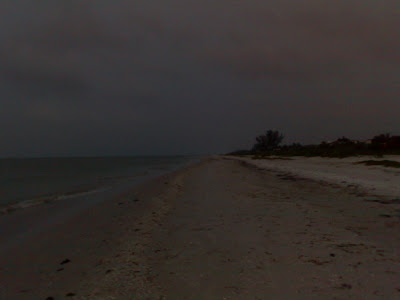

 A mermaid and a sea turtle.
A mermaid and a sea turtle.

YES, Pooky had been there.
 Along the way, I found a little drill and a juvenile horse conch.
Along the way, I found a little drill and a juvenile horse conch. By the time our walk was over, the sun was trying very hard to peak out from behind the clouds.
By the time our walk was over, the sun was trying very hard to peak out from behind the clouds.
This video was taken in front of Sanibel Moorings.
Best viewed in HD on YouTube by clicking the screen below.
I am pretty sure I saw is a Sea Cucumber on the beach this morning. It's the first time I've seen one, but someone had described them to me before. I looked it up and learned several new things about them.
They are related to the starfish and the sea urchin and there are hundreds of different species found throughout the world. Sea cucumbers are usually a dull, dark colour and often warty. They have leathery skin, embedded with bony particles and have several rows of tiny tubular feet along the length of their body. The tube feet are hollow, muscular projections that are used to move themselves along. The species that don't have the little tube feet, move by muscular movements of their body. Some sea cucumbers hide in grassy beds and some dig into the mud and sand. They have a mouth at one end of their body that has tentacles to gather food. The other end is the anal opening that is used for both respiration and discharging wastes. It feeds on tiny marine animals and organic matter.
When a sea cucumber is threatened, it can shoot sticky threads from its waste hole. Enemies, such as fish and crabs, get caught in the threads. They can continually grow new sets of these threads. Some sea cucumbers can mutilate their own bodies as a defense mechanism or out of fear. They violently contract their muscles and spew some of their internal organs out of their anus. (That is what I think the stuff you see on the sand near the end of the sea cucumber, probably is.) Some scientists think they also do this to protect themselves from building up too much waste in their bodies. They they can grow new innards in about six weeks.
Another tidbit of information I found was that scientists have determined that the sea cucumber uses the same ordinary processes to repair its brain that it does to heal small injuries. They feel that the Sea cucumbers will probably provide them with the key to deciphering how to regenerate our tissues, or at least find out what is needed to do this.
The one I saw this morning was still alive, so we put it back out in the water.
I've looked at the tall bushes or trees, along the side of the Buttonwood Lane beach access for a couple of years and wondered what they are. Sometimes the flowers are yellow, sometimes they are red and sometimes I see both colors. Today I searched online until I finally found it.
They are Hibiscus tiliaceus. Some of the more common names are Mahoe, Sea Hibiscus, Cotton Tree, and Majagua. It is an evergreen shrub or spreading tree that grows to around 25 ft high and nearly as wide. It is salt tolerant and produces flowers almost all year long. The dark green leaves are large 4 to 8 inches long, leathery looking, and heart shaped. The flowers look like Hibiscus flowers, funnel shaped with five petals. The flowers start out yellow in the daytime and turn red by evening. That explanation sure put my curiosity to rest. The different colored blooms had me confused.
I thought I might like to have one of these and keep it trimmed to a smaller bush. But then I saw the Warning: Mahoe is listed as a Category II pest plant by the Florida Exotic Pest Plant Council, which means that it has the potential to be invasive and to disrupt native plant communities by displacing native species. (Category I species are KNOWN to be invasive.) Mahoe is not on Florida's list of prohibited plants, however, and is sometimes sold by commercial nurseries. It is not recommend for use in Florida landscapes.
Tuesday, June 23, 2009
Tuesday Turtle Walk & Sea Cucumbers
Today was our 8th turtle patrol of the season. There are still just 2 nests in our zone and there was no new turtle activity to report. (There were two bags of trash, however.) It was a little warm with a slight breeze. The only thing that saved us from a meltdown was that the sun didn't show for the entire walk. The low for the day was 82 degrees and the high ended up at 90. The Gulf temp is also 90.
Subscribe to:
Post Comments (Atom)
2 comments:
Fascinating. And when I feel sorry for myself, I'll have to remember that at least I don't have to breathe through my butt! :D
A sea cucumber, how cool! I'm just drooling at the two itty bitty shells you found. Wish our high temps were 90; it's been 100 and 101 for the last several days. Ugh!
Post a Comment